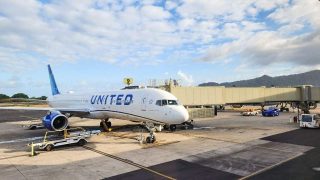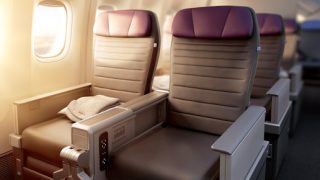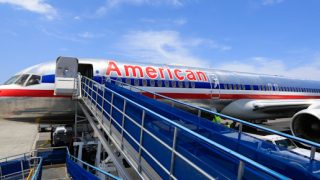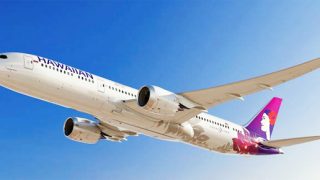If you’re tired of only flying the cramped B737 and A321 narrow-body planes to Hawaii, hope might be on the horizon. And this time, it’s coming from the beleaguered Boeing company. Granted, you’ll have a wait for this new Boeing 797, which is making headlines again today. This aircraft could be the next essential multi-airline fleet for Hawaii flights or another passenger fail if it’s not widebody.
In a tentative agreement with its labor union, Boeing agreed that the deal, to be ratified later this week, “would commit Boeing to building the replacement to the 737 at its Pacific Northwest facilities if the project is started during the life of the contract.”
This marks a significant step forward, especially for routes that can best leverage mid-size, long-range planes, like those to Hawaii.
Historical context of aircraft in Hawaii travel.
Over the years, the Boeing 737 and, more recently, the Airbus A321 have become the primary aircraft for connecting Hawaii to the mainland’s west coast. These narrow-body planes, while efficient, and allowing for routes that previously didn’t exist, often receive mixed feedback from passengers and flight attendants, especially when it comes to long transpacific flights.
Economy and business class travelers frequently express frustrations about cramped seating, especially on these extended duration routes. Flight attendants trying to provide service from a small galley also feel the limited space. This makes the case for an upgraded, more spacious aircraft that balances efficiency with passenger comfort more compelling.
Design and features of the Boeing 797.
There is still uncertainty about whether the new plane will feature a single or twin-aisle design. While speculation points to a twin-aisle layout to enhance passenger comfort on long-haul routes like those to Hawaii, others think it could serve as a narrow-body replacement.
Regardless of the final configuration, the Boeing 797 is expected to provide an improved range and different seating configurations, addressing passenger comfort and airline operational needs. A key question remains whether only the dreaded 3-across seating will persist in economy, as in terms of new single-aisle planes, only the A220 offers relief, but it hasn’t yet been used for Hawaii flights.
Strategic importance for flights to Hawaii.
For carriers like Hawaiian and Alaska Airlines, the Boeing 797 presents a strategic opportunity to replace aging aircraft, particularly Hawaiian’s workhorse A330s, which will be approaching the end of their service life when the 797 becomes available. The introduction of the 797 allows these airlines to modernize their fleets with more fuel-efficient, long-range planes. This could reduce operating costs and increase profitability on transpacific routes, ensuring more efficient and sustainable operations for flights to Hawaii.
Airline executives and aerospace are starting to weigh in on this news. The consensus is that Boeing must act quickly to address the gap in mid-range, mid-capacity aircraft that airlines want.
Impact on Hawaii tourism overall.
The introduction of the Boeing 797 could significantly impact Hawaii’s tourism industry. A more comfortable, fuel-efficient, longer-range aircraft could enhance flight accessibility, potentially driving down airfare costs thanks to a alleged 40% improvement in aircraft efficiency.
Additionally, with Hawaii’s focus on eco-friendly tourism, this aircraft aligns with the state’s sustainability goals by reducing carbon emissions and environmental impact. This combination of economic and environmental benefits could reshape the future of travel to the islands.
Boeing’s upcoming 797 could mark a new chapter for Hawaii air travel.
The aircraft promises, in theory, to offer the ideal blend of comfort, efficiency, and sustainability, setting a new standard for transpacific flights. However, as an undoubtedly prolonged development timeline unfolds, all eyes will be on Boeing, which has faced significant challenges in recent years. The aviation world and Hawaii aficionados will be watching closely to see how this new plane could reshape the future of travel to Hawaii, both in terms of passenger experience and environmental impact.
Are you excited about the possibility of this new plane for Hawaii flights?
Get Breaking Hawaii Travel News







Just my $.02 but I think Boeing could make a hit with a slightly larger diameter narrow body, but plan it for a twin aisle 2-2-2 seating. I believe the total diameter would not need to be more than 3.5-4 feet from a 737, putting it about midway between the 737 and A330.
Great Hawaii articles as I am Annual Hawaii visitor for North America break away from Mainland. Keep up the great writing. Thank you. Robert M.
Boeing and Airbus design and build the planes, the airlines determine how cramped the seats are. For them it’s about making a profit. And most customers it’s about getting the lowest airfare. You pay for what you get. A new airplane model will not fix cramped seats, only the airlines or the customers can do that.
Sometimes I think that we are quick to look outside our selves for solutions to our problems. Here, again, we look to Boeing to make it more advantages to bring tourists to our islands. My wife and I have lived here since 2016 and travel extensively, as we are divers. In our travels , we meet many travelers and discuss our issues with tourism here at home. In the discussions, we are finding that travelers are going to other destinations, because of perceived attitudes about Hawaii. Most all discussions are the same. We project an anti-tourist attitude. We hit tourists with high prices, tac on costs, and restrictions everytime they turn around. We fail to understand that we are in competition for their business. Are statistics indicates that. It is not the airplane that is the problem, it is us. We are killing the goose that lays the golden eggs.
Given the cash burn from ba’s problems with the max death plane, 777x engines falling off and 787 having high fatigue plus poor build quality its an open question if they will be still in the commerical biz by decades e d let alone have the cash to build a cldan sheet xdsign.
BA has had a leadership problem with the last few CEOs. The new CEO came from the aviation sector. I retired from that company and he was universally liked there. Kelly O. has extensive experience running high tech companies including M&A and grew up in the Midwest. He is very personable and has both an MBA and an engineering degree so he doesn’t get “gurued”. If anyone can turn BA around, he can. Don’t be surprised if he does a major reorganization that focuses each business unit on Their business and customers and sheds business’ that are just holding the rest back. 797 will eventually come but there’s a lot of other work to do first.
I heard on the news the Boeing contract gave the workers a 25% pay increase. Do you really think the cost for airline tickets will be cheaper?
This might give workers incentive to provide better worker attitudes and quality improvements in workmanship building the planes so where are the cost savings. Cheaper Parts or a lot bigger planes? Hopefully bigger planes won’t lead to a plane overload problem.
If the 797 happens at all it will still be years.
797 needs to wait for the next generation engines and cruise at .95 Mach. I also agree that double aisle A/C have no advantage.
Let’s just hope Boing first gets their act together to build safe, reliable, quality aircraft (and spacecraft) with their current line and talk about new aircraft series after That has been accomplished…
Best Regards
There has been talk about the 797 for many years now. The original thought that it was going to be a new version of the 757. But Airbus was destroying Boeing and their answer was the unsafe MAX. The 797 should have been designed from the start instead of putting modern technology on something designed in the late 50’s. If the 797 is how we in the industry have heard it might be, it most likely will be a long narrow body aircraft. Thus single aisle. The 757 was always a great aircraft to fly in and work on. So if they take elements of the 757 and implement it into the 797, it might turn out great. That is if the Boeing company takes their time and doesn’t put profits over safety like they did with the MAX
The A220 offers a 2+3 cabin but more importantly it usually has more legroom and wider seats in coach than the current offerings. It has l excellent overhead bins too. It has all the latest technology and the same super efficient geared fan engines the latest A321 uses. Sized for the ‘220. Airbus has 2 assembly lines going but there’s still a long wait list. BA has their hands full so don’t hold your breath for the 797.
The A220 was first designed and built by Bombardier and flew as their C series aircraft for 2 years until being acquired by Airbus in 2019. The 797 would be built by Boeing. Two totally different manufactures.
I have not had the pleasure of flying on an A220. My neighbor flies it often to visit family. However the A220 has not been without problems. One, which is not an Airbus or Boeing problem has to do with the P& W engines. Problems with the landing gear fuse pins missing IS an Airbus manufacturing issue. Another build problem is the fuselage and corrosion problems. Just like automobiles, all aircraft have some problems of one sort or another. We are just fortunate that aircraft are as safe as they are.
There is next to zero chance that the 797 would be launched during the contract. Most of the efficiencies of the next generation jet will come from next gen engines. Those engines probably will not be ready until 2030. The engine makers can not afford to have another fiasco like the P&W GTF. Entery into service of the new Boeing plane is 2035 or later.
There is an illogical perception that somehow widebody (twin-aisle) planes are more comfortable, despite little evidence to support it.
Economy seats aren’t any wider, the seat pitch isn’t any greater, and personal space isn’t any more generous.
The only difference is that airlines have yet to fit space-saver (contortionist-friendly) lavatories to their existing widebody fleets.
The 737 was a shortened version of the 707 frame. Maybe a shortened version of the 747-8i with the latest development advances added could please everyone except Airbus. Fancy a small double decker with high efficiency twin engine and composite construction..,
Bring ticket prices down? Don’t think so. Just drive profits up.
I’ve seen efficiency promises before but never any savings passed on to us.
Why isn’t any airline using the A220 for Hawaii flights yet?
They can’t make them fast enough.
It takes quite a long time to get an aircraft ETOPS certified
A twin-aisle aircraft would make such a difference. No more dreaded 3-across seating please.
Have you been aboard most twin-aisle aircraft lately?
The most common configurations are:
787: 3 x 3 x 3
777: 3 x 4 x 3
767s with 2 x 3 x 2 seating are nearing the end of their service lives and are not being replaced. That only leaves some Airbus A330 aircraft with 2 x 4 x 2 configurations.
So a 2-4-2 is better?
Slap some AeroShark on them planes meanwhile
Yes; it’s the only way (excepting an antique Boeing 767) to avoid a middle seat; without paying for first class.
While it sounds remotely promising, I hope it’s not just more marketing hype. Boeing has had too many problems and delays.